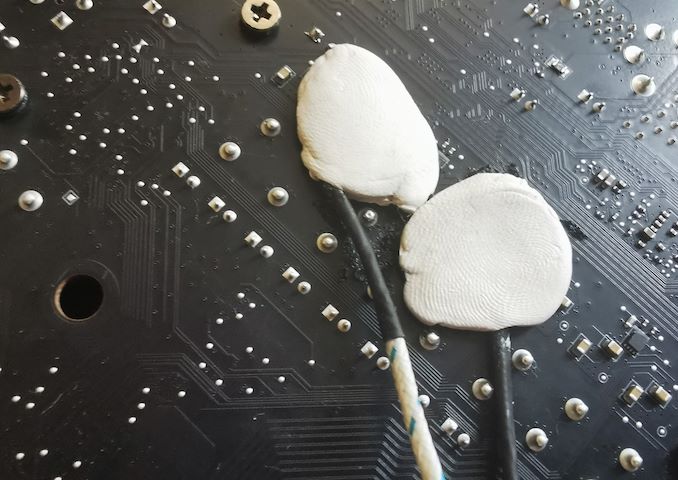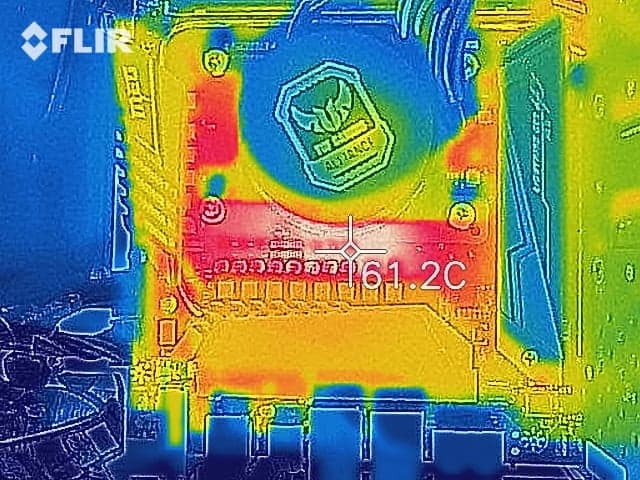The MSI MEG X570 Ace Motherboard Review: Ace in the Hole at $369
by Gavin Bonshor on July 18, 2019 11:00 AM EST- Posted in
- Motherboards
- AMD
- MSI
- AM4
- Zen 2
- Ryzen 3000
- X570
- MEG
- X570 Ace
- 3700X
- Ryzen 3700X
Power Delivery Thermal Analysis
One of the most requested elements of our motherboard reviews revolves around the power delivery and its componentry. Aside from the quality of the components and its capability for overclocking to push out higher clock speeds which in turn improves performance, is the thermal capability of the cooling solutions implemented by manufacturers. While almost always fine for users running processors at default settings, the cooling capability of the VRMs isn't something that users should worry too much about, but for those looking to squeeze out extra performance from the CPU via overclocking, this puts extra pressure on the power delivery and in turn, generates extra heat. This is why more premium models often include heatsinks on its models with better cooling designs, heftier chunks of metal, and in some cases, even with water blocks.
Testing Methodology
Our method of testing is going to focus on if the power delivery and its heatsink are effective at dissipating heat. We run an intensely heavy CPU workload for a prolonged method of time and apply an overclock which is deemed safe and at the maximum that the silicon on our AMD Ryzen 7 3700X processor allows. We then run the Prime95 with AVX2 enabled under a torture test for an hour at the maximum stable overclock we can, which puts insane pressure on the processor. We collect our data via three different methods which include the following:
- Taking a thermal image from a birds-eye view after an hour with a Flir Pro thermal imaging camera
- Securing two probes on to the rear of the PCB, right underneath CPU VCore section of the power delivery for better parity in case a probe reports a faulty reading
- Taking a reading of the VRM temperature from the sensor reading within the HWInfo monitoring application

Two K-Type Thermal Probes attached to the rear of the power delivery on the MSI MEG X570 Ace
The reason for using three different methods is that some sensors can read inaccurate temperatures, which can give very erratic results for users looking to gauge whether an overclock is too much pressure for the power delivery handle. With using a probe on the rear, it can also show the efficiency of the power stages and heatsinks as a wide margin between the probe and sensor temperature can show that the heatsink is dissipating heat and that the design is working, or that the internal sensor is massively wrong. To ensure our probe was accurate prior to testing, I personally binned 10 and selected the most accurate (within 1c of the actual temperature) for better parity in our testing.
For thermal image, we use a Flir One camera as it gives a good indication of where the heat is generated around the socket area, as some designs use different configurations and an evenly spread power delivery with good components will usually generate less heat. Manufacturers who use inefficient heatsinks and cheap out on power delivery components should run hotter than those who have invested. Of course, a $700 flagship motherboard is likely to outperform a cheaper $100 model under the same testing conditions, but it is still worth testing to see which vendors are doing things correctly.
Thermal Analysis Results

We measured 61.2°C on PCB between the CPU socket and power delivery
The MSI MEG X570 Ace uses a 12-phase CPU VCore design with an International Rectifier IR35201 running in a 6+2 configuration with six IR3599 doublers for the VCore section. This is quite an effective design and should be more than capable of handling of reaching the thermal limits of the processor long before the VRM reaches its own limits. Its heatsink also features an interesting design as the aluminium heatsinks on the power delivery is connected via a heat pipe to the chipset heatsink which is channelled around the memory slots. The chipset heatsink is actively cooled and although it is designed to keep the X570 chipset cool, it should provide a little thermal relief to the power delivery; in theory at least.
As we get more results, we will endeavour to update this chart when more models have been tested
Note - The ASRock B450 Gaming ITX-ac model crashed instantly every time the small FFT torture test within Prime95 was initiated. At anything on the CPU VCore above 1.35 V would result in instant instability. The Ryzen Master auto-overclocking function failed every time it tried to dial in settings, but it does however operate absolutely fine at stock, and with Precision Boost Overdrive enabled. Either the firmware is the issue, or the board just isn't capable of overclocking the Ryzen 3700X with extreme workloads with what is considered a stable overclock on the X570 chipset. We will re-test this in the future.
Our thermal testing shows that not only is MSI's heatsink design effective on the MEG X570 Ace, but the power delivery actually dissipates heat appropriately. We ran our AMD Ryzen 7 3700X testbed sample at 4.1 GHz with a CPU VCore of 1.475 V just to generate as much pressure as we could. We did get thermal throttling when using the maximum allowed VCore of 1.55 V and decided to dial it back a touch. The sensor integrated into the power delivery gave us a reading of 66°C after an hour of our stress test, while our VRM probe temperature sensor on the rear of the PCB gave us a reading of 61°C. It was very warm in our test area at the time of testing with an ambient temperature of between 29 and 30°C, so this probably attributed to slightly warmer conditions than usual. One of the notable aspects was that we frequently hit CPU temperature limitations before we hit VRM thermal limitations. All-in-all, the MSI MEG X570 Ace performs well under our thermal testing conditions and we have no fears that this model won't handle overclocks on any of the current Ryzen 3000 range with its effective and efficient design.











92 Comments
View All Comments
Irata - Friday, July 19, 2019 - link
Also, the MSI MEG Ace's LGA1151 version is not really much cheaperrocky12345 - Friday, July 19, 2019 - link
I am not sure about this "all at a fairly reasonable price." Since when is $369USD considered a reasonable price for a mid tier board? For us Canadians that translates to $483CAD and then if you factor in the retailers increase it becomes over $500CAD. Great review though thank you.peevee - Friday, July 19, 2019 - link
Exactly. The price is totally unreasonable. It's a price for server MBs.rocky12345 - Friday, July 19, 2019 - link
I made another post on this but since there is no edit function I am posting again on the post times for these new boards. 18-31 seconds before it even starts to boot to Windows ouch that is a long time. My current board form power press to Windows desktop only takes up to about 11-12 seconds and it also has a lot of features to setup after it posts to the screen. I have not been on an AMD platform for a very long time so maybe it is just an AMD thing and they take longer to get everything ready I am not sure. Maybe it is the same with the new Intel stuff as well.By the time these new boards get you to Windows on my current system I would have either had YT open and already playing a video or Netflix logged in and picking a movie or already reading an article from Anandtech site.
pavag - Saturday, July 20, 2019 - link
+1Daveteauk - Thursday, April 9, 2020 - link
Rocky - my ACE posts to DT in 14 seconds, and the OS is loaded. You must have done something wrong in BIOS or your setup.beginner99 - Friday, July 19, 2019 - link
only 4 sata ports on a >$350 board is a no go. It's the only one in this price range with that limit. I currently have 2 ssds, 3hdds and a bluray connected via sata. Admittedly 1 ssd could go, and 1 hdd, bluray probably also but the one time every 2 years you need it...Anyway a asus Strix-e is cheaper and has no obvious downside to this board and 6 sata (or is it 8?). I'm aware some sata ports get disabled if you use multiple m.2 but having either option is clearly a plus.rocky12345 - Friday, July 19, 2019 - link
Yep same 4 ports would not be enough for me as well. Heck even my old z77x board supports up to 9 sata drives granted only 5 of those are Sata 6 the other 4 are only Sata 3 ports.peevee - Friday, July 19, 2019 - link
Nobody in their right mind should use more than 2 SATA devices with a MB like that for Ryzen 3 CPUs. Did you also connect perforated tape readers to your Pentium 4?Your main SSDs should be PCIe 4.0 x4 for this MB to make sense, for example. 1 old BD + maybe, MAYBE some new 8TB+ HDD if you need to store a lot of RAW video. But maybe an external enclosure with RAID would be better, to turn it on only when needed.
pavag - Saturday, July 20, 2019 - link
I have 8 SATA drives connected.